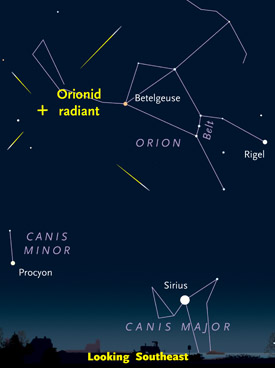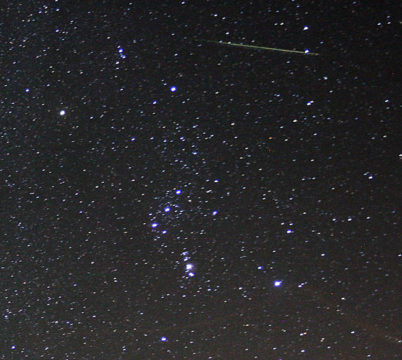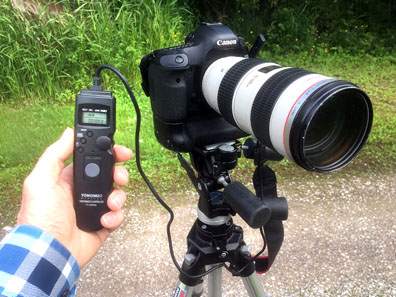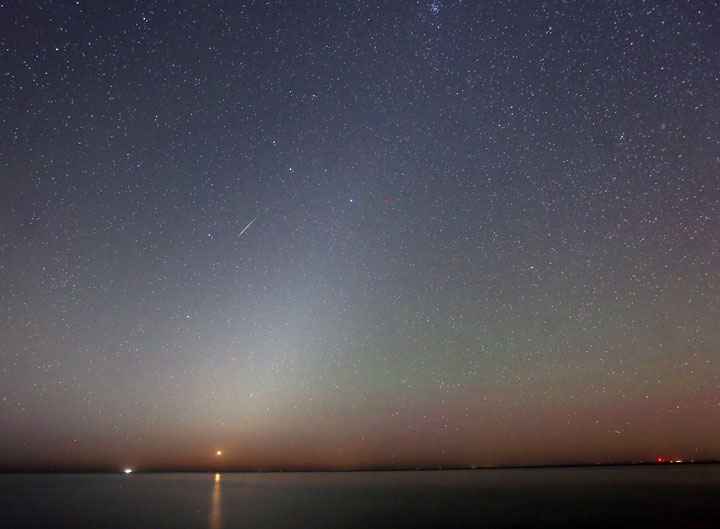See what cosmic dust can do! Head outside this weekend for the peak of the Orionid meteor shower and an eyeful of zodiacal light.

It's all about the dust. Something that most people consider a nuisance or even a danger plays a crucial role in so many universal processes. Without it, there'd be no planets and no us, since dust is required to build these things. Dust provides the nuclei upon which water vapor condenses to form rain and clouds, and by extension, rainbows. No dust, no rainbows.
Comet tails? Dust. Meteor showers? Dust again. This week, the wasteful ways of Comet Halley will literally come to light as particles shed by the comet from coma and tail tear through the upper atmosphere. Earth's orbit intersects that of the famous comet twice a year, first in early May to bring the Eta Aquariid meteor shower, then again in the third week of October to fire up the Orionids.
The shower's expected to peak on Sunday morning, October 22nd. For a couple days before and after, rates will be around 10 per hour, but at maximum, we can expect up to 25 dusty darts per hour to shoot from Orion's upraised club under dark skies. No worries about the Moon, either, which sets in the evening sky long before the radiant rises.
Orionids are swift, striking the atmosphere at 238,000 km/hour, a combination of the stream's speed and Earth's orbital velocity of 108,000 km/hour — the nightside of the planet faces directly into the shower in the early morning hours so we get bonked head on. Orionid meteors can zip across the sky so fast, I've done double-takes wondering if what I just saw was a meteor or not.
Meteors start as meteoroids, solid particles in space in orbit about the Sun. They range in size from grains of sand to small pebbles and generally weight less than a gram or two. But what they lack in mass, they make up for in speed.

Bob King
Much of the kinetic energy possessed by a moving meteoroid is converted into heat and light when it strikes the air between 80 and 120 km above our heads. Air molecules slam into and excite atoms in the particle, while the particle's extreme speed excites molecules in the surrounding air. The clash pumps the electrons in both materials into higher energy states, but only briefly. A moment later they return to their previous "relaxed" states, launching packets of light (photons) of different colors in the process. We see that this all as a bright streak or "shooting star." A blue-green meteor betrays the dust's excited magnesium, an orange one, sodium.
Most meteor showers produce occasional meteors that leave a wake or train that can last for many seconds. They're caused by free electrons sprung loose from their comfy atomic homes to wend their way back to their parent ions for a luminous reunion. Every meteor is another example of how the finger of the cosmos touches Earth. Let there be light.
Use the scroll and left button on your mouse to explore this interactive graphic of the Orionid meteor shower.
Peter Jenniskens / Ian Webster
While the radiant, the point in the sky from which the Orionids appear to stream, is up by midnight, you'll get the best view of the shower when Orion stands tall in the southeastern sky between 2:00 and 5:30 a.m. Meridian crossing occurs at 5 a.m. local time. Plan to spend an hour or more with the shower to see a good assortment of meteors. I don a warm coat and lay out on sleeping bag on the deck or driveway in a state of relaxed awareness, ready for whatever might come.
As always, sporadic meteors are part of the mix. These "strays" pepper the sky at the rate of 4–8 meteors per hour toward dawn and are easily parsed from shower meteors by following their trails backwards — if they don't point to the radiant, they're pretenders.

Bob King
If you have a camera and tripod, see if you can capture an Orionid or two with a time exposure. I use a 20-mm focal length lens set to f/2.8 (wide-open aperture), ISO 1600, and 30-second exposures. You can use your finger to press the shutter button or purchase an inexpensive intervalometer on eBay or Amazon, or at your local camera store, that will automatically take pictures at set intervals, thereby freeing you up to relax and watch meteors. Point the camera off to one side of the radiant, or for something more scenic, include the shower's namesake constellation in the photo. One bit of advice: regularly check your front lens element. In cool, damp conditions it can fog up in as little as a half hour. A quick blast from a hair dryer will take care of the problem.
If you plan to watch the shower, stay up a little longer into early twilight for yet another manifestation of the beauty of dust — the zodiacal light. The light has two seasons, dusk in spring and dawn in autumn. If you have a dark eastern sky and face that direction about two hours before sunrise, you'll notice a big cone of diffuse light, broad at the base and tapering along its length. The soft, glowing nature of the light resembles that of the Milky Way. But while the Milky Way’s appearance results from the combined light of billions of distant suns, the zodiacal light originates from sunlight scattered off quadrillions (at least!) of tiny, dust-mote sized comet grains and bits of asteroid debris.

Bob King
The dust nearest the Sun is lit brightest, hence the bright and broad base of the cone. The farther up and away you look from the Sun, the less intense the scattered light and the fainter the cone becomes. Though visible well before dawn, I've found the zodiacal light most impressive at the very start of twilight or about 1 hour 45 minutes before sunup.
Like you, I'm hoping for clear skies this weekend. My wish, as always, is to see more of what dust can do before I'm forced to bite it.
 16
16









Comments
Jim Fenner
October 18, 2017 at 3:06 pm
Hi Bob,
An engaging article and you may have persuaded me to lose some valuable sleep to see some Orionids
However the speeds quoted are all little high, where article has 000km it should be just km
Warm regards
Jim
Canberra
You must be logged in to post a comment.
Bob KingPost Author
October 18, 2017 at 4:38 pm
Hi Jim,
Thanks, and I'm glad you might be persuaded to lose a little sleep, but those speeds are correct. They're in km/hour remember, so yes, the speed of the Orionids are about 238,000 km/hour. Darn fast!
You must be logged in to post a comment.
Anthony Barreiro
October 19, 2017 at 1:42 pm
Thanks Bob. That is a beautiful picture of the zodiacal light and Venus rising over the lake. Was the zodiacal light as visible to the eye as it appears in this photo? (There's a bit of green airglow as well.)
You must be logged in to post a comment.
Bob KingPost Author
October 19, 2017 at 5:31 pm
Thanks Anthony. The zodiacal light was incredible that morning -- one of the best displays ever. Simply towering. The photo scrunches it into a little box, but the real thing is SO much bigger. Your keen eye caught the green - indeed, it's airglow!
You must be logged in to post a comment.
Anthony Barreiro
October 23, 2017 at 3:39 pm
Thanks Bob. I have never seen the zodiacal light. One more reason I should get out of the city more often.
You must be logged in to post a comment.
Mike McCabe
October 19, 2017 at 2:13 pm
Thanks as always Bob for an inspiring article! Some time ago I got a tip from someone on a simple way to control dew buildup on a DSLR lens when shooting long time lapses - simply rubber band one of those chemical hand warmers to the underside of the lens. Works like a charm - a dew heater on the cheap!
You must be logged in to post a comment.
Bob KingPost Author
October 19, 2017 at 5:32 pm
Hi Mike,
Thank you! I've always wondered whether those hand warmers would work in the open or if they had to been enclosed in a glove. I love the idea and will try it out on the upcoming shower. Thank you for sharing the tip!
You must be logged in to post a comment.
Zubenelgenubi 61
October 20, 2017 at 4:34 pm
I think it is to be regretted that the Orionid Shower is getting so much media attention. Not from S & T of course- this is a very good article well suited for the experienced amateurs most of us are- but other outlets. I remember trying to see the Orionids from north of Chicago many years ago when I was a teenager, when light pollution was not nearly as bad as today, and I saw not a single one. From moderately dark skies these days I see maybe 10-15/hour, soon before dawn. I think between the late hour, these meteors being fast, and not typically being very bright, a newbie will see very few. Only the Perseid & Geminid showers are really worthy of general attention, or the rare predicted storm from the Leonids.
You must be logged in to post a comment.
Anthony Barreiro
October 23, 2017 at 3:42 pm
Yeah, facebook put up a special post saying the Orionids would be "spectacular" and you should "take a moment to enjoy them." They're not spectacular, and it takes more than a moment to see even one.
You must be logged in to post a comment.
Graham-Wolf
October 20, 2017 at 8:39 pm
Thanks Bob, for the timely reminder!
Back in the 80's when I was in IMO (and even on it's international council), we strove to get folks to observe the "Halley's").... Orionids and Eta Aquarids:- both observable from NZ. These days, I've "jumped the fence to Comets from meteors /fireballs, but it's an easy task get up, leave the lights off, step outside, an hr or two before before dawn onset, and look down into a radiant ear near Gemini.
Trust me, the rest will just happen... be patient!
A very reliable meteor shower, and highly recommended. IMO has a good website, but I think, Bob, you may have "eclipsed" them with your own latest effort. I've always appreciated a KISS approach to these things. Good luck out there to all observers, and best wishes from NZ!
Graham W. Wolf at 46 South, Dunedin, NZ
You must be logged in to post a comment.
George Gliba
October 21, 2017 at 12:20 pm
Bob,
I was out early last night, but too early to have very good rates, for the pre-maximum Orionids.
However, from 12:03 AM to 02:03 AM EDT I was able to see 14 Orionids. There was only 3
Orionids seen the 1st hour, but the rates picked up the 2nd hour to 11 per hour. The best one
seen was a nice O magnitude yellow Orionid with a 3 second train seen at 1:45 AM EDT. The
transparency was excellent both hours with a LM-6.5.
Starry Skies,
GWG
Screech Owl Hill Observatory
Mathias, West Virginia
You must be logged in to post a comment.
Bob KingPost Author
October 23, 2017 at 12:30 am
Hi George,
Thanks for your report. Much appreciated especially by those who were clouded out.
You must be logged in to post a comment.
Graham-Wolf
October 21, 2017 at 9:32 pm
Hi Bob
No luck with the Orionids these last two mornings.
Aggressive frontal systems have clouded or drizzled out most of NZ, 'til further notice.
Last night a a pea-soup fog hung over the Dunedin subhurb summits til about local midnight, then lifted. Well... whaddya know:- above THAT was a full-on overcast sky, right through to sunrise.
Sarcastically, all I got was a "Total occultation of the Orionids"!
Graham W. Wolf:- 46 South, Dunedin, NZ.
You must be logged in to post a comment.
Bob KingPost Author
October 23, 2017 at 12:29 am
Hi Graham,
I'm with you in spirit. All clouds here, too 🙁
You must be logged in to post a comment.
Graham-Wolf
October 25, 2017 at 8:44 pm
Hi Bob.
In response to your recent query about Comet 29p/ S W 1....
It underwent a massive and well documented outburst ~ August 28th.
Did a few semi-maximal outbursts a few days apart throughout early September (most unusual).
Should have dropped back to normal long ago (fainter than Mv 15), but apparently still hasn't.
Been sitting in the high 11s for the last 3 weeks or so. Goiato, Wyatt, and I have been regularly checking on the comet... we all get similar readings!
Waxing Crescent Moon quite an eyeful this week, in the early evening sky.
By lunch-time, today, was already above local Eastern horizon, and ethearally visible in perfectly clear skies. Mid-night to dawn obs of the comets still doable for now...
FYI
Graham.W.Wolf at 46 South, Dunedin, NZ.
You must be logged in to post a comment.
Michel Deconinck
October 26, 2017 at 1:29 pm
Hi Bob
I have to thank you a lot for all those information that you are sharing here with the whole world. By example October 21st you make my day (…my night in fact) !
After reading this post, I went out of my little village to observe the Orionid meteors and the zodiacal light. My first plan was also to sketch the comet 24P/Schaumasse, but here without any success.
For the meteor observation, as always since 40 years now, I sketch on a paper the main stars as references for future meteor positions, then I put the meteor traces. After that it’s quite easy to make the ZHR calculation, out of the sporadics, I found 19 Orionids tonight.
I often want to set-up a souvenir via a watercolour. This one is in your gallery under the topic “meteors, comets and asteroids”
Keep up this good work for us Bob, we really appreciate !
Michel from Provence - France
You must be logged in to post a comment.
You must be logged in to post a comment.